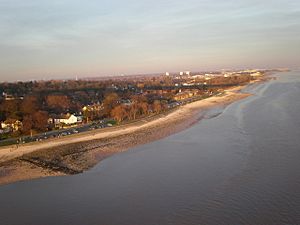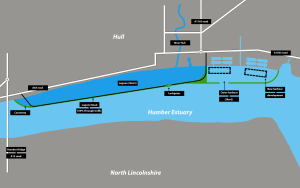Lagoon Hull facts for kids
Lagoon Hull is a huge project planned for the Humber Estuary in England. It's expected to cost about £1.5 billion. The project aims to build a large stone wall, called a causeway, between Hessle and Kingston upon Hull.
This causeway will create a lagoon and help control the water from the River Hull. It will make the river less affected by the tides. The causeway will be about 11 kilometers (7 miles) long. It will also include a new dual carriageway road. This road will go from the A63 at Hessle to Hull Docks. It will help reduce traffic in the city centre.
A main goal of Lagoon Hull is to protect the city of Hull from future floods. This is especially important as sea levels are expected to rise. The project will also create a safer area for ships. This new dock area will be protected from big waves and strong tides.
Why Hull Needs Flood Protection
The city of Hull has faced serious flooding many times. This has happened throughout the 1900s and 2000s. A very high tide in 1969 led to the building of the River Hull tidal surge barrier. This barrier only stops flooding upstream on the River Hull. However, most of Hull is actually below the high-tide level.
In 2013, there was a huge flood and tidal surge. The barrier in Hull almost couldn't hold back the water. While it saved Hull from major flooding, the Port of Immingham on the other side of the estuary was flooded.
One idea to stop flooding was to build a huge barrier across the whole Humber Estuary. This would protect many towns on both sides. But this barrier would need to be four times bigger than the Thames Barrier. In 2019, it was estimated to cost £10 billion. After the 2013 floods, local leaders asked the government for money. They wanted to improve flood defences.
The Lagoon Hull project was first announced in 2019. However, people had been working on the idea for six years before it was made public.
What the Lagoon Project Involves
The plan is to build a stone causeway from Hessle to Hull docks. This will create a lagoon. It will also block the mouth of the River Hull, making it non-tidal. The causeway will be over 11 kilometers (7 miles) long. A new dual carriageway road will cover about 9.6 kilometers (6 miles) of this.
The lagoon itself will be about 5 square kilometers (2 square miles). It will have special floodgates. These gates will let water out into the Humber Estuary in a controlled way. This will act as a strong flood defence for Hull. Experts believe this defence could protect the city from tidal surges for 100 years.
A study looked at the 2013 floods. It found that if the lagoon had been there, Hull would have been 100% safe. Also, flooding in the wider estuary would have been reduced by 80%.
The new dual carriageway will connect to the A63 road near the Humber Bridge. It will run along the edge of the lagoon, avoiding Hull city centre. It will then connect with other main roads near the docks. The causeway will also have paths for walking and cycling.
East of the lagoon, a new outer harbour will be built. This area will be about 2 square kilometers (0.8 square miles). It will make it easier for ships to enter the docks. It will also create a new dock area that is safe from tides and waves. This outer harbour project already has permission to be developed. It will use about 84 hectares (208 acres) of land. In 2019, the whole project was estimated to cost £1.5 billion.
Expert Opinions on the Project
Independent experts have studied the Lagoon Hull project. These include ABPmer, the University of Hull, and the Environment Agency. They looked at concerns that the project might make flooding worse elsewhere. Their studies found that these fears were not true.
The Humber Estuary is not very deep, only about 6.5 meters (21 feet) on average. Because of this, tidal surges work differently here than in deeper rivers. The causeway would actually help reduce the amount of water entering the estuary during a tidal surge.
If enough money is raised and planning permission is given, the project will take time. First, there will be five to ten years of detailed studies. After that, building would take another five years. This means the project could be finished by 2030 at the earliest.



